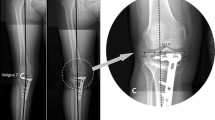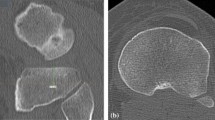Abstract
Introduction
We determined (1) the range of the hip–knee–ankle (HKA) angle in the native or pre-arthritic limbs of patients with a contralateral total knee arthroplasty (TKA); and when mechanical alignment is planned (2) the relationships between the HKA angle and the tibial width, and the relative narrowing between the medial and lateral compartments and (3) the effect of tibial width on the range of narrowing.
Methods
The HKA angle, distal lateral femoral angle (DLFA), and proximal medial tibial angle (PMTA) were measured on the native limb of 102 subjects (53 female) treated with contralateral TKA. The sine of the angle of the resection gap (PMTA minus 90° subtracted from the DLFA minus 90°) multiplied by the tibial width and by narrow (59 mm), average (75 mm), and wide (91 mm) tibias computed relative narrowing.
Results
The HKA angle ranged from 8° varus to − 7° valgus; 20% had constitutional varus (≥ 3°) and 11% constitutional valgus (≤ − 3°). The HKA angle strongly predicted (r 2 = 0.87) and tibial width weakly predicted (r 2 = 0.06) relative narrowing. For narrow, average, and wide tibias, the maximum medial narrowing was 9, 11, 14 mm and maximum lateral narrowing was 7, 9, and 11 mm, respectively (p < 0.0001).
Conclusion
When mechanical alignment is planned, there is greater relative narrowing between compartments when the pre-arthritic limb greatly deviates from a 0° HKA angle and the tibia is wide. These limbs may need soft-tissue releases until neutral postoperative limb alignment of 0° and negligible varus–valgus laxity are achieved.
Level of evidence
IV, therapeutic study.







Similar content being viewed by others
References
Jeffery RS, Morris RW, Denham RA (1991) Coronal alignment after total knee replacement. J Bone Jt Surg Br 73(5):709–714
Bellemans J, Colyn W, Vandenneucker H, Victor J (2012) The Chitranjan Ranawat award: is neutral mechanical alignment normal for all patients? The concept of constitutional varus. Clin Orthop Relat Res 470(1):45–53. doi:10.1007/s11999-011-1936-5
Allen MM, Pagnano MW (2016) Neutral mechanical alignment: is it necessary? Bone Jt J 98-B(1 Suppl A):81–83. doi:10.1302/0301-620X.98B1.36403
Bonner TJ, Eardley WG, Patterson P, Gregg PJ (2011) The effect of post-operative mechanical axis alignment on the survival of primary total knee replacements after a follow-up of 15 years. J Bone Jt Surg Br 93(9):1217–1222. doi:10.1302/0301-620X.93B9.26573
Matziolis G, Adam J, Perka C (2010) Varus malalignment has no influence on clinical outcome in midterm follow-up after total knee replacement. Arch Orthop Trauma Surg 130(12):1487–1491. doi:10.1007/s00402-010-1064-9
Morgan SS, Bonshahi A, Pradhan N, Gregory A, Gambhir A, Porter ML (2008) The influence of postoperative coronal alignment on revision surgery in total knee arthroplasty. Int Orthop 32(5):639–642. doi:10.1007/s00264-007-0391-0
Parratte S, Pagnano MW, Trousdale RT, Berry DJ (2010) Effect of postoperative mechanical axis alignment on the fifteen-year survival of modern, cemented total knee replacements. J Bone Jt Surg Am 92(12):2143–2149. doi:10.2106/JBJS.I.01398
Vanlommel L, Vanlommel J, Claes S, Bellemans J (2013) Slight undercorrection following total knee arthroplasty results in superior clinical outcomes in varus knees. Knee Surg Sports Traumatol Arthrosc 21(10):2325–2330. doi:10.1007/s00167-013-2481-4
Nishida K, Matsumoto T, Takayama K, Ishida K, Nakano N, Matsushita T, Kuroda R, Kurosaka M (2016) Remaining mild varus limb alignment leads to better clinical outcome in total knee arthroplasty for varus osteoarthritis. Knee Surg Sports Traumatol Arthrosc. doi:10.1007/s00167-016-4260-5
Calliess T, Bauer K, Stukenborg-Colsman C, Windhagen H, Budde S, Ettinger M (2016) PSI kinematic versus non-PSI mechanical alignment in total knee arthroplasty: a prospective, randomized study. Knee Surg Sports Traumatol Arthrosc. doi:10.1007/s00167-016-4136-8
Dossett HG, Estrada NA, Swartz GJ, LeFevre GW, Kwasman BG (2014) A randomised controlled trial of kinematically and mechanically aligned total knee replacements: two-year clinical results. Bone Jt J 96-B(7):907–913. doi:10.1302/0301-620X.96B7.32812
Eckhoff DG, Bach JM, Spitzer VM, Reinig KD, Bagur MM, Baldini TH, Flannery NM (2005) Three-dimensional mechanics, kinematics, and morphology of the knee viewed in virtual reality. J Bone Jt Surg Am 87(Suppl 2):71–80. doi:10.2106/JBJS.E.00440
Howell SM, Howell SJ, Kuznik KT, Cohen J, Hull ML (2013) Does a kinematically aligned total knee arthroplasty restore function without failure regardless of alignment category? Clin Orthop Relat Res 471(3):1000–1007. doi:10.1007/s11999-012-2613-z
Howell SM, Papadopoulos S, Kuznik K, Ghaly LR, Hull ML (2015) Does varus alignment adversely affect implant survival and function six years after kinematically aligned total knee arthroplasty? Int Orthop 39(11):2117–2124. doi:10.1007/s00264-015-2743-5
Shetty GM, Mullaji A, Bhayde S, Nha KW, Oh HK (2014) Factors contributing to inherent varus alignment of lower limb in normal Asian adults: role of tibial plateau inclination. Knee 21(2):544–548. doi:10.1016/j.knee.2013.09.008
Thienpont E, Schwab PE, Cornu O, Bellemans J, Victor J (2017) Bone morphotypes of the varus and valgus knee. Arch Orthop Trauma Surg 137(3):393–400. doi:10.1007/s00402-017-2626-x
Song MH, Yoo SH, Kang SW, Kim YJ, Park GT, Pyeun YS (2015) Coronal alignment of the lower limb and the incidence of constitutional varus knee in Korean females. Knee Surg Relat Res 27(1):49–55. doi:10.5792/ksrr.2015.27.1.49
Luyckx T, Vanhoorebeeck F, Bellemans J (2015) Should we aim at undercorrection when doing a total knee arthroplasty? Knee Surg Sports Traumatol Arthrosc 23(6):1706–1712. doi:10.1007/s00167-014-3185-0
Roth JD, Howell SM, Hull ML (2015) Native knee laxities at 0 degrees, 45 degrees, and 90 degrees of flexion and their relationship to the goal of the gap-balancing alignment method of total knee arthroplasty. J Bone Jt Surg Am 97(20):1678–1684. doi:10.2106/JBJS.N.01256
Roth JD, Hull ML, Howell SM (2015) The limits of passive motion are variable between and unrelated within normal tibiofemoral joints. J Orthop Res 33(11):1594–1602. doi:10.1002/jor.22926
Gu Y, Howell SM, Hull ML (2016) Simulation of total knee arthroplasty in 5 degrees or 7 degrees valgus: a study of gap imbalances and changes in limb and knee alignments from native. J Orthop Res. doi:10.1002/jor.23492
Gu Y, Roth JD, Howell SM, Hull ML (2014) How frequently do four methods for mechanically aligning a total knee arthroplasty cause collateral ligament imbalance and change alignment from normal in white patients? J Bone Jt Surg 96(12):e101
Peters CL, Jimenez C, Erickson J, Anderson MB, Pelt CE (2013) Lessons learned from selective soft-tissue release for gap balancing in primary total knee arthroplasty: an analysis of 1216 consecutive total knee arthroplasties: AAOS exhibit selection. J Bone Jt Surg Am 95(20):e152. doi:10.2106/JBJS.L.01686
Goudie S, Deep K (2014) Collateral soft tissue release in primary total knee replacement. Comput Aided Surg 19(1–3):29–33. doi:10.3109/10929088.2014.889212
Bellemans J, Vandenneucker H, Van Lauwe J, Victor J (2010) A new surgical technique for medial collateral ligament balancing: multiple needle puncturing. J Arthroplast 25(7):1151–1156. doi:10.1016/j.arth.2010.03.007
Howell SM, Papadopoulos S, Kuznik KT, Hull ML (2013) Accurate alignment and high function after kinematically aligned TKA performed with generic instruments. Knee Surg Sports Traumatol Arthrosc 21(10):2271–2280. doi:10.1007/s00167-013-2621-x
Nedopil AJ, Howell SM, Hull ML (2016) Does malrotation of the tibial and femoral components compromise function in kinematically aligned total knee arthroplasty? Orthop Clin N Am 47(1):41–50. doi:10.1016/j.ocl.2015.08.006
Nedopil AJ, Howell SM, Rudert M, Roth J, Hull ML (2013) How frequent is rotational mismatch within 0 degrees ± 10 degrees in kinematically aligned total knee arthroplasty? Orthopedics 36(12):e1515–e1520
Sabharwal S, Zhao C, Edgar M (2008) Lower limb alignment in children: reference values based on a full-length standing radiograph. J Pediatr Orthop 28(7):740–746. doi:10.1097/BPO.0b013e318186eb79
Matsuda S, Miura H, Nagamine R, Mawatari T, Tokunaga M, Nabeyama R, Iwamoto Y (2004) Anatomical analysis of the femoral condyle in normal and osteoarthritic knees. J Orthop Res 22(1):104–109. doi:10.1016/S0736-0266(03)00134-7
Khakharia S, Bigman D, Fragomen AT, Pavlov H, Rozbruch SR (2011) Comparison of PACS and hard-copy 51-inch radiographs for measuring leg length and deformity. Clin Orthop Relat Res 469(1):244–250. doi:10.1007/s11999-010-1460-z
Griffin FM, Insall JN, Scuderi GR (2000) Accuracy of soft tissue balancing in total knee arthroplasty. J Arthroplast 15(8):970–973. doi:10.1054/arth.2000.6503
Author information
Authors and Affiliations
Corresponding author
Ethics declarations
Conflict of interest
On behalf of all authors, the corresponding author states that there is no conflict of interest.
Funding
The authors have not received grant support or research funding and do not have any proprietary interests in the materials described in the article.
Ethical approval
An institutional review board approved this study (IRB 918840-1).
Informed consent
For this type of study formal consent is not required.
Rights and permissions
About this article
Cite this article
Singh, A.K., Nedopil, A.J., Howell, S.M. et al. Does alignment of the limb and tibial width determine relative narrowing between compartments when planning mechanically aligned TKA?. Arch Orthop Trauma Surg 138, 91–97 (2018). https://doi.org/10.1007/s00402-017-2824-6
Received:
Published:
Issue Date:
DOI: https://doi.org/10.1007/s00402-017-2824-6




